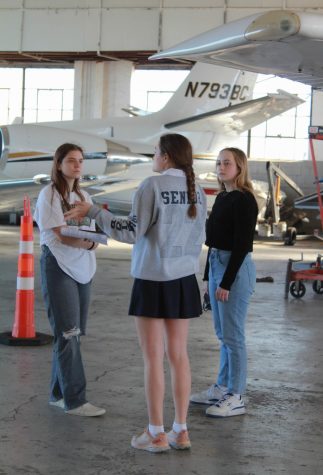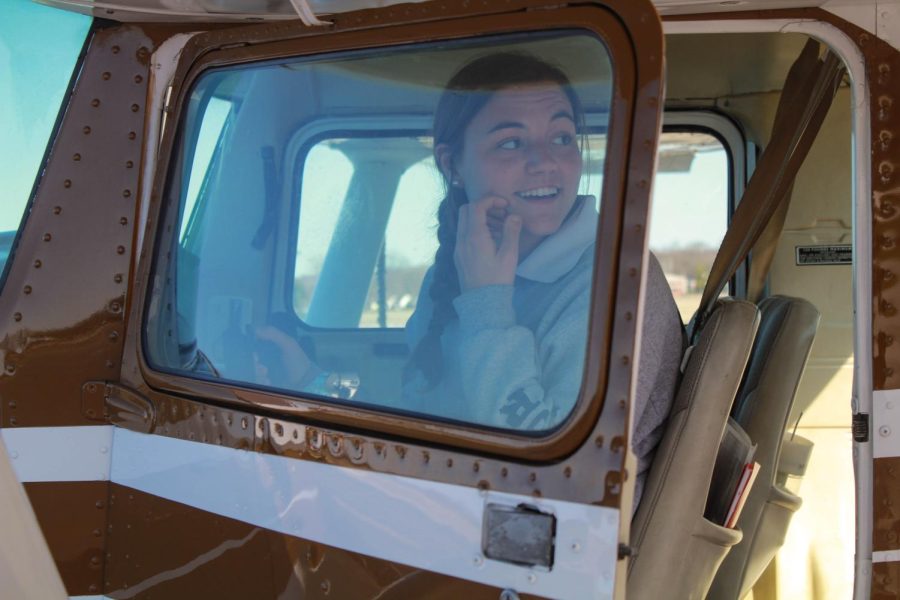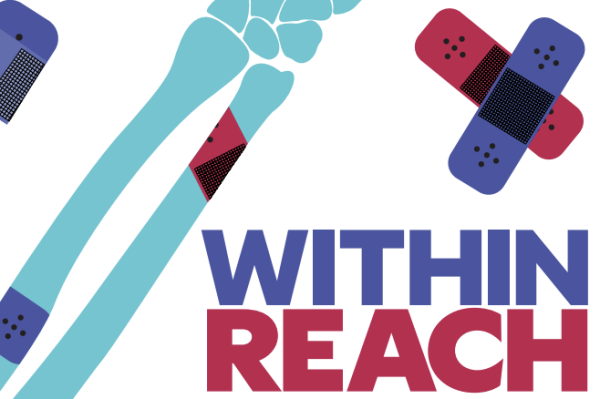Ascent
Student pilots in Louisville are learning to fly before they can drive. This is how they’re soaring toward their futures.
Photos by Mya Cummins
Pilot’s Seat At Bowman Field, Charlotte McCarthy, age 18, glances back to explain the controls of ‘Brown Bear’, one of Flight Club’s Cessna 150 planes on March 14.
The hum from the airplane engine buzzed in Charlotte McCarthy’s ears as her instructor sat beside her in the passenger seat. The Cessna 150, which Flight Club 502 students had affectionately nicknamed Big Bird, had been McCarthy’s second home in the recent weeks of constant practice. Since the beginning of her training, McCarthy, 16 at the time, knew she would have to practice recovery in flight, a crucial part of learning to pilot an aircraft. With wind speeds safe and visibility high, it was a perfect day for a specific flight recovery practice: simulated stalls, one of the highest tests of composure and positive control.
As she initiated a stall and the air rolling over Big Bird’s wings suddenly stopped, McCarthy felt the nose of the plane tip downward, and her view of the clouds was replaced by the city below her. The plane began plummeting toward the ground, and the humming engine became drowned out by the hurtling winds. Wings caught in the momentum, both student and instructor felt the plane begin to over-rotate, and McCarthy couldn’t break from the whirlwind surrounding them. The stall had gone haywire, leaving both passengers in grave danger, suspended thousands of feet in the air.
They spun faster and faster toward the ground, but McCarthy’s greatest priority was staying calm. Positive control needed to be maintained even in the most stressful situations. Her instructor immediately reached over, firmly reassuring McCarthy while handling the instrument panel expertly. As she managed to pull the plane out of the spin, hundreds of feet lower than they had been and closer to the ground than she would have liked, McCarthy recovered. Hands slightly trembling, she brought the plane down to the ground, where she remained on edge.
McCarthy, an 18-year-old senior at Sacred Heart Academy, had often heard people she knew talk about avoiding small planes, and had invited friends only for them to decline to fly with her. Unlike them, flying never struck her as something so terrifying or dangerous, especially after being raised in a family full of pilots. She had never really understood why until she had gotten so close to making a fatal mistake.
“I could have just killed myself and my instructor,” McCarthy said. “Now I understand why people are so scared to go in … a tiny tin can, basically. I mean, it’s nothing.”
Nothing like flying had ever brought her so close to danger, yet it had only made her confidence grow stronger, both in herself and in her abilities.
For those living in Louisville, it isn’t uncommon to hear airplanes flying overhead. Because of the UPS world hub and regional airports, the constant air traffic through our skies is hard to ignore. Buzzing helicopters, roaring passenger planes, and the occasional jet for special events, such as Thunder Over Louisville, often turn our heads upward throughout the day.
Sitting in classrooms, walking on sidewalks, or laying in our beds, we may sometimes wonder who’s sitting in the seats 35,000 feet above our heads, and who’s up there flying. Not many people would guess that it could be a student barely old enough to get their driver’s license. Next time we look up, it might be a 16 or 17-year-old soaring through the skies above us, thanks to the increased number of flight schools in Louisville.
Flight Club 502 is one of those schools. It is one of many whose offices are part of Bowman Field, a regional airport in Louisville. However, unlike the schools that surround it, Flight Club is unique in an unexpected way — it’s almost entirely student-run. The president of Flight Club, despite what many people might assume, is a senior attending Sacred Heart Academy. The finance and outreach managers, as well as the copresidents, are all high school students working together to organize their flight education and reach for future goals.
“All the directors are seniors, and one or two are juniors. And that’s just because we’re trying to build resumes,” McCarthy, the president, said. The flight school is almost entirely run by students from schools across Louisville, working only with a few adults to run the club.
Flight Club does not have a very long history — it was only founded recently, in 2015, by eight high-school-age girls who wanted a ground school class, where they could learn the basics of flying and aerodynamics. Charlotte McCarthy’s sister, Eloise McCarthy, was one of those young women. They turned to their moms, who knew a woman named Laura Jones, an aerospace professional, and founded the school together.
Women in aviation have always been hard to come by, but especially in 2015, when less than half of the number of female student pilots were learning than today. In 2021, only about 6% of licensed pilots were women. Representation for women in aviation is scarce among leadership and technical roles as well, with the Center for Aviation reporting 15 female airline CEOs or directors throughout the world in 2010. Only one of them headed an airline in North America. However, the number of female student flyers makes up the largest majority of female pilots in any section of aviation, and has been growing since the early 2010s. With numbers of girls learning to fly on the rise, McCarthy is very aware of her significance within Flight Club and the aviation world.
“Less than 10% of pilots are women, which is just insane to me. And especially at our age,” McCarthy said, “there are not a lot of teenage pilots, obviously, but there’s probably even fewer teenagers that are girls that have their license.”

Charlotte McCarthy (age 18) stands in one of Bowman Field’s Hangers and explains to her the challenges she faced earning her private pilots license on March 14. (Photos by Mya Cummins)
The establishment of Flight Club 502 is a very direct representation of women looking to earn their license increasing within Louisville. Ever since McCarthy’s sister and seven others started a small charge to create flight opportunities for women in our city, Flight Club has seen its number of female students grow much larger from its humble beginnings. Compared to McCarthy, who is already a licensed pilot, Brooks Barnum, a 16-year-old sophomore at Sacred Heart Academy, is just joining ground school.
“Actually, Miss Jones is my neighbor. So everyone on my street… all the kids have joined Flight Club. She encouraged me to come to meetings. I was like, alright, I’ll come. I came and I just really loved it here,” Barnum said. “To see STEM within a new context that interested me… just kept me coming.” McCarthy and Barnum, despite being at opposite ends of the license process, have both seen Flight Club play major roles in their lives. Both women have been surprised by the enjoyment they found through learning to fly. In fact, McCarthy joined out of boredom, chronically absent from activities to do over the COVID-19 lockdown. She was uninterested in lacrosse and looking for a new hobby. But she didn’t expect a simple text to a family friend — “Can I have a flight lesson?” — to introduce some of the most remarkable parts of her life.
“I didn’t think that I’d really fall in love with it the way I did,” McCarthy described.
Within Flight Club, people like McCarthy and Barnum, who are both interested in careers outside of aviation, get their license for the experience instead of future goals. But there are also people who plan to fly for the rest of their lives, after falling in love with it.
Lillie Roberts, a 16-year-old sophomore at Assumption High School and current Flight Club student, is one of them. She has been training to get her pilot’s license for two years. She saw her life change because of flying, something she hadn’t ever seen coming. Just like Barnum, she is one of many female Flight Club members who have joined in the past few years.
“If you think about it, it’s kind of a butterfly effect type thing,” Roberts described.
Her journey took off when she met two Space Camp hopefuls in a hotel pool on family vacation. At first, her brother, Grayson, was more interested than she was. With aspirations of becoming an Air Force pilot, he immediately took to flying. He joined the Civil Air Patrol, getting a chance at being Air Force before turning 18, as she watched from afar, cheering him on separately.
However, after seeing her brother always reach for the sky, Roberts, with encouragement from her father, went to Flight Club for her first lesson with less than high expectations. But quickly she found herself drawn to the freedom and community that flight school provided her. From attending a space camp in Huntsville, Alabama as a young child, her life was transformed. For her, because of Flight Club and because of her family, flying is more than just an activity done for enjoyment — it’s a life plan and a big part of her growth. For her, Flight Club was lifesaving.
“I’ve always described it as therapy, I think, because you quite literally leave all your problems on the ground,” Roberts said. “And since the only thing you’re worrying about is the plane and flying the plane.”
Through flying, these students haven’t just learned a unique skill. They learn confidence. Not only that of controlling a plane four times larger than themselves, but confidence that translates into social life and maturity. By interacting with students from other schools, professionals and trainers, and even Air Traffic Controllers while flying, they gain a steadiness that carries throughout their day-to-day interactions and choices.
“I used to be such a timid person. I was so afraid to ask someone, ‘Hey, will you let me do this?’” Roberts said. “And I think in aviation, everyone has the whole mindset of like, the worst thing someone can say is no… that’s the worst that can happen. Now I will go out of my way to be like, ‘Hey, can we go do this?’ And they’re like, ‘Yeah, let’s do it!’ I think that has changed my life.”
Unlike many young people, flight school students have opportunities far beyond just flying because of a sense of leadership and direction that many others are struggling to find during their teenage years.
Charlie Klap, a 16-year-old sophomore at Walden School close to getting his license, has been training with Flight Club 502 since 2018. He is another member planning on going forward into adulthood with a flight career, like Roberts. As a child, Klap heard about the long trips his father would go on for work. As a UPS pilot, Sacha Klap was a major part of inspiring his son. As Klap’s awe turned into curiosity, and his future became clear, he joined Flight Club to help develop his dream. He would get his license first, and become a professional pilot as a career. His objective? To join his father.
“UPS is the end goal. I eventually want to fly with my dad,” Klap said.
Klap represents the hard work and planning that goes into flying at such a young age. Planning a path to get to UPS requires a variety of experience and dedication from the very beginning, and earning your pilot’s license is only the first step in a long journey.
“Generally, flying is a really big process. I want to get my private pilot’s license, and then you have to get all these ratings, so then I want to get my instrument,” he said. With so many steps to go through in order to be qualified for air careers, these students must be hardworking from the start.
. . .
There are over 900 flight schools across the country, but mainly for adults. Flight Club 502 provides an opportunity for students to get the private pilot’s license (PPL), allowing them to fly an aircraft legally. However, while it is an incredible offer to young adults, and has helped those like Roberts and McCarthy find important people and experiences, flying is still very exclusive because of the cost. On average, earning a PPL costs $10,000. In more expensive cases, it can go up to $16,000. Furthermore, aviation is overwhelmingly white, standing at more than 85% since 2010. Because of this, flight school becomes hard to afford, let alone have access to, for many lower income families and minorities.
“No one in my family has gone on to be a commercial pilot with Delta, or UPS, or anything. It’s always just been a nice, expensive hobby,” McCarthy said.
Fortunately, Flight Club, due to its management by mainly students and volunteering adults, is more affordable than many other flight schools, with lower annual dues and only a $35 fee for each hour of flight. But because of the preparation needed for solo flights and other tests toward a PPL, the costs can add up.
“When I was getting ready to solo for the first time, I was flying three to four times a week,” Klap said.
Practicing is a huge part of being able to pass and earn the license. With 3-4 flights every week for an hour or more, a small fee like $35 can rack up and create disparities between people who can and can’t afford it when preparing for a final flight test. A discussion of fairness for aspiring pilots leads to one glaring question: how do you offer an expensive class to people who can’t afford it?
The Academy at Shawnee has answered that question. They teach students how to pilot an aircraft — completely free.
Shawnee is a magnet school in west Louisville. Unlike many magnet schools, Shawnee focuses on career planning and giving students opportunities outside of the academic world early on. Specifically, it is the only school in JCPS that has an aviation magnet program — and the only in the nation to have a FAR Part 141 Private Pilot course, a class that involves students with real planes, flight practice, and abides by the Federal Aviation Administration, a section of the U.S. Department of Transportation. In the AIM Academy magnet, sophomore year students can take ground classes, and by the time they’re a junior, they can start in an actual plane. This level of learning is usually only available for university students, and Shawnee sets students, some of which would not be able to attend university otherwise, on a path toward steady career options. And Shawnee students never have to worry about affording the classes.
Both Shawnee and Flight Club 502 are unique, both for their youth opportunities, and Shawnee for the financial freedom it gives its students. Having programs that allow for learning at an early age and stability in career choice opens up the future for many teenagers.
. . .
Klap, Roberts, Barnum, and McCarthy are all at different stages of receiving their pilot licenses. But through the opportunities Flight Club has made for them and the ones they have made for themselves, they are connected by a love for flying and all its different forms. And despite the dangers, they persevere, dedicated to earning their wings. Every student in Flight Club, and in AIM Academy, has a story — why they joined, how they’re reaching toward their goals, and how flying has changed their lives.
“Just go for it,” Klap said. “If you’re interested in it, just try it.” •

(Design by Silas Mays)
Donations are collected through The Publishers, duPont Manual High School's booster club for J&C. On The Record relies completely on sponsorships, advertisements, and donations to produce and distribute each issue. Please consider donating to our cause, and helping the student journalists of OTR amplify youth voices for years to come.

Silas is a senior designer for On the Record. This is his third year on staff and is excited to get back to designing spreads. Silas is involved in various...








